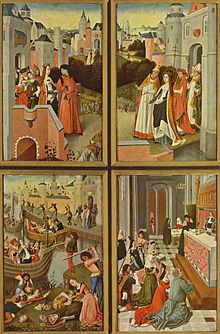Master of the (Bruges) legend of St. Ursula
- Master of the (Bruges) legend of St. Ursula
-

Altarpiece of the legend of St. Ursula, right side
The Master of the legend of St. Ursula was a Flemish painter active in the fifteenth century. His name is derived from a polyptych depicting scenes from the life of Saint Ursula painted for the convent of the Black Sisters of Bruges; the city appears in the background of a number of the paintings, in which the belfry and tower of the Church of Notre-Dame. Consequently it is possible, given the stages of construction of the belfry, to determine that the altarpiece was painted either before 1483 or somewhere between 1493 and 1499. Today the panels have been dispersed to a number of museums around the world.
A few other paintings have been attributed to the Master on the basis of style; these include a triptych of the Nativity in the Detroit Institute of Arts, as well as paintings in Brussels, Cherbourg, Toronto and Rochester. Among his pupils are believed to have been both Rogier van der Weyden and Hans Memling.
References
- This article incorporates information from the equivalent article on the Italian Wikipedia.
- This article incorporates information from the equivalent article on the French Wikipedia.
Categories:
- Flemish painters
- Anonymous artists
- 15th-century people
- Netherlandish painter stubs
Wikimedia Foundation.
2010.
Look at other dictionaries:
Master of the legend of St. Ursula — may refer to: Master of the (Bruges) legend of St. Ursula Master of the (Cologne) legend of St. Ursula This disambiguation page lists articles associated with the same title. If an int … Wikipedia
Master of the Legend of Saint Ursula — The Master of the Legend of Saint Ursula was a Flemish painter active in the fifteenth century. His name is derived from a polyptych depicting scenes from the life of Saint Ursula painted for the convent of the Black Sisters of Bruges; the city… … Wikipedia
literature — /lit euhr euh cheuhr, choor , li treuh /, n. 1. writings in which expression and form, in connection with ideas of permanent and universal interest, are characteristic or essential features, as poetry, novels, history, biography, and essays. 2.… … Universalium
Hans Memling — Hans Memling † Catholic Encyclopedia ► Hans Memling Flemish painter, b. about 1430 35; d. at Bruges 11 August, 1494. This date was discovered in 1889 by Père Henri Dusart in a MS. chronicle of the library of St. Omer, which adds that… … Catholic encyclopedia
Memlinc, Hans — (c. 1440 1494) Hans Memlinc was Rogier van der Weyden s most faithful follower. A native of the town of Seligenstadt on the Main, Germany, he moved to Bruges, Flanders, sometime around 1465. By the following year, he was a member of the Bruges … Dictionary of Renaissance art

